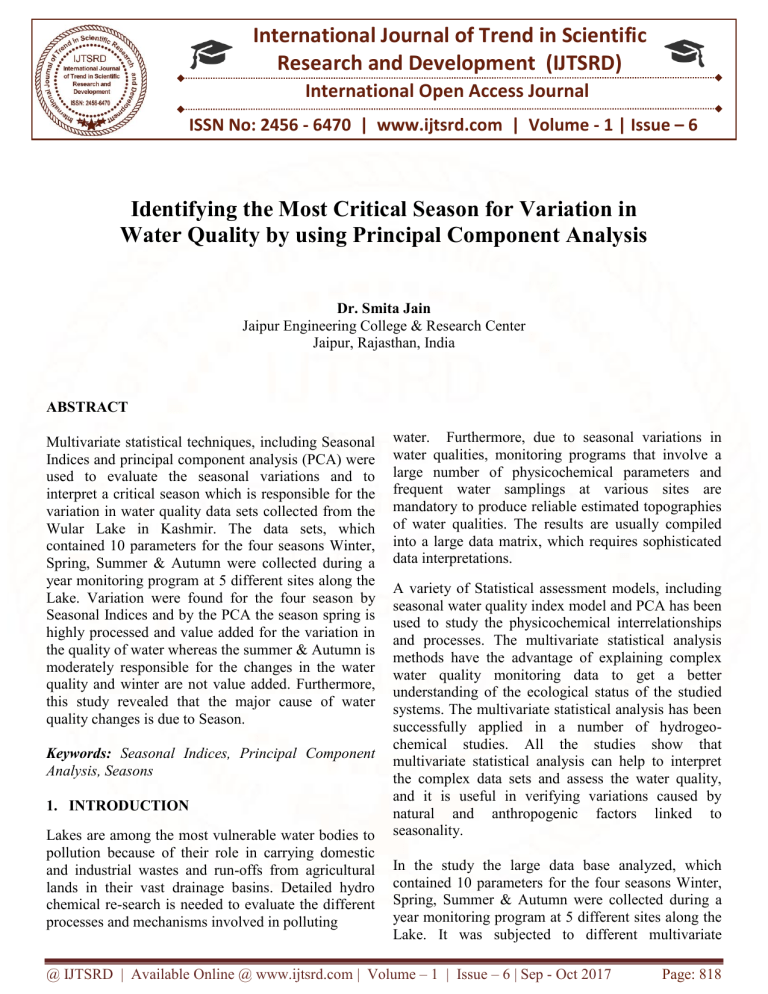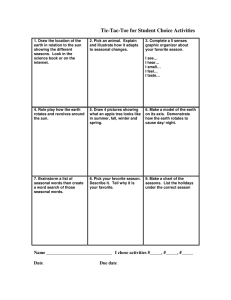
International Journal of Trend in Scientific
Research and Development (IJTSRD)
International Open Access Journal
ISSN No: 2456 - 6470 | www.ijtsrd.com | Volume - 1 | Issue – 6
Identifying the Most Critical Season for Variation in
Water Quality by using Principal Component Analysis
Dr. Smita Jain
Jaipur Engineering College & Research Center
Jaipur, Rajasthan, India
ABSTRACT
Multivariate statistical techniques, including Seasonal
Indices and principal component analysis (PCA) were
used to evaluate the seasonal variations and to
interpret a critical season which is responsible for the
variation in water quality data sets collected from the
Wular Lake in Kashmir. The data sets, which
contained 10 parameters for the four seasons Winter,
Spring, Summer & Autumn were collected during a
year monitoring program at 5 different sites along the
Lake. Variation were found for the four season by
Seasonal Indices and by the PCA the season spring is
highly processed and value added for the variation in
the quality of water whereas the summer & Autumn is
moderately responsible for the changes in the water
quality and winter are not value added. Furthermore,
this study revealed that the major cause of water
quality changes is due to Season.
Keywords: Seasonal Indices, Principal Component
Analysis, Seasons
1. INTRODUCTION
Lakes are among the most vulnerable water bodies to
pollution because of their role in carrying domestic
and industrial wastes and run-offs from agricultural
lands in their vast drainage basins. Detailed hydro
chemical re-search is needed to evaluate the different
processes and mechanisms involved in polluting
water. Furthermore, due to seasonal variations in
water qualities, monitoring programs that involve a
large number of physicochemical parameters and
frequent water samplings at various sites are
mandatory to produce reliable estimated topographies
of water qualities. The results are usually compiled
into a large data matrix, which requires sophisticated
data interpretations.
A variety of Statistical assessment models, including
seasonal water quality index model and PCA has been
used to study the physicochemical interrelationships
and processes. The multivariate statistical analysis
methods have the advantage of explaining complex
water quality monitoring data to get a better
understanding of the ecological status of the studied
systems. The multivariate statistical analysis has been
successfully applied in a number of hydrogeochemical studies. All the studies show that
multivariate statistical analysis can help to interpret
the complex data sets and assess the water quality,
and it is useful in verifying variations caused by
natural and anthropogenic factors linked to
seasonality.
In the study the large data base analyzed, which
contained 10 parameters for the four seasons Winter,
Spring, Summer & Autumn were collected during a
year monitoring program at 5 different sites along the
Lake. It was subjected to different multivariate
@ IJTSRD | Available Online @ www.ijtsrd.com | Volume – 1 | Issue – 6 | Sep - Oct 2017
Page: 818
International Journal of Trend in Scientific Research and Development (IJTSRD) ISSN: 2456-6470
statistical techniques (Seasonal Indices, principal
components analysis (PCA)) with a view to extract
information about the similarities or dissimilarities
among the seasonal water quality. Variation were
found for the four season by Seasonal Indices and by
the PCA the season spring is highly processed and
value added for the variation in the quality of water
whereas the summer & autumn is moderately
responsible for the changes in the water quality and
winter is not value added.
2. MATERIAL AND METHODS
Five different Stations at Wular Lake in Kashmir were
selected in order to study the Physicochemical
Characteristics of lake water samples for the years.
The study based on secondary data collected from
various relevant government departments, published
and unpublished reports.
For the seasonal indices data were collected for the
ten parameters of the lake such as Dissolved Oxygen
(mg/l), pH, Alkalinity (mg/l), Chloride (mg/l), Total
hardness (mg/l), Conductivity ( us/cm.), Total
solids(mg/l), TDS (mg/l), TSS (mg/l) and Nitrate
(mg/l), for the four seasons Winter, Spring ,Summer
& Autumn. Software Minitab is used to evaluate the
seasonal indices for the different parameters.
After that we apply the Principal Component Analysis
(with the help of Minitab) on the seasonal indices for
the four seasons to identify the critical season for the
variation in water quality.
3. RESULTS
The analysis of the Table: 1 shows the seasonal
indices for the different seasons.
Parameters
Winter
Spring
Summer
D.O.
Ph.
Alkalinity
Chloride
Conductivity
Total
Hardness
Total Solids
TDS
TSS
Nitrate
1.159
1.004
0.782
0.977
0.95
0.891
1.007
0.995
1.004
1.083
1.169
1.354
0.821
0.995
1.223
1.002
0.918
0.883
Autum
n
1.013
1.006
0.991
0.938
0.964
0.872
0.713
0.793
0.503
0.864
1.447
1.274
1.857
1.249
0.928
0.957
0.89
0.97
0.912
0.975
0.751
0.921
Table: 1
The Principal Component Analysis by the four
components is represented by the following tables:
Eigen analysis of the Covariance Matrix
Eiganvalues
Proportion
Cumulative
.10203
0.842
0.842
0.01795
0.148
0.990
0.00116
0.010
1.000
.000
.000
1.000
Scree Plot of Winter, ..., Autum
0.10
Eigenvalue
0.08
0.06
0.04
0.02
0.00
1
2
3
4
Component Number
@ IJTSRD | Available Online @ www.ijtsrd.com | Volume – 1 | Issue – 6 | Sep - Oct 2017
Page: 819
International Journal of Trend in Scientific Research and Development (IJTSRD) ISSN: 2456-6470
Principal Component Analysis
Variables
Winter
Spring
Summer
Autumn
PC1
-0.507
0.826
-0.091
-0.227
PC2
-0.580
-0.254
0.771
0.063
REFERENCES
PC3
-0.398
-0.058
-0.386
0.830
PC4
-0.498
-0.499
-0.498
-0.505
4. DISCUSSION AND CONCLUSION
On the basis of the above study we conclude that all
the parameters showing the seasonal indices greater
than one in the spring season and in summer &
autumn the values of the indices is almost one and for
some parameters it’s one. It reveals that there is a
variation in the water quality of the lake due to
season.
PCA helped to identify that the Season responsible for
water quality variations and the principal components
revealed that the season spring is highly processed
and value added in the variation in the quality of
water whereas the summer & autumn is moderately
responsible for the changes in the water quality and
winter is not value added.
1) T.W. Anderson (1984). An Introduction to
Multivariate Statistical Analysis, Second Edition.
John Wiley & Sons.
2) R. Johnson and D. Wichern (1992). Applied
Multivariate Statistical Methods, Third Edition.
Prentice Hall.
3) Cheng, B. and Titterington, D. M., (1994), Neural
Networks: A Review from a
Statistical Perspective, Statistical Science, 9(1), pp
2-54.
4) Haith D.A. (1976), Water quality in New-York
Rivers, Journal of environmental engineering
division, ASCE, 102, pp 1-15
5) Rastogi. G.K. and Sinha D. K., A novel approach
to water quality management through correlation
study, Journal of Environmental Research and
Development, 2011, 5 ,(4), 1029-1035.
6) H. Boyacioglu, “Water pollution sources
assessment by multivariate statistical methods in
the Tahtali Basin, Tur-key,” Environmental
Geology, Vol. 54, No. 2, pp. 275-282, 2008.
7) V. Simeonov, J. A. Stratis, C. Samara, G.
Zachariadis, D. Voutsa, A. Anthemidis, M.
Sofoniou, and T. Kouimtzis, “Assessment of the
surface water quality in Northern Greece,” Water
Research, Vol. 37, No. 17, pp. 4119- 4124, 2003.
@ IJTSRD | Available Online @ www.ijtsrd.com | Volume – 1 | Issue – 6 | Sep - Oct 2017
Page: 816





